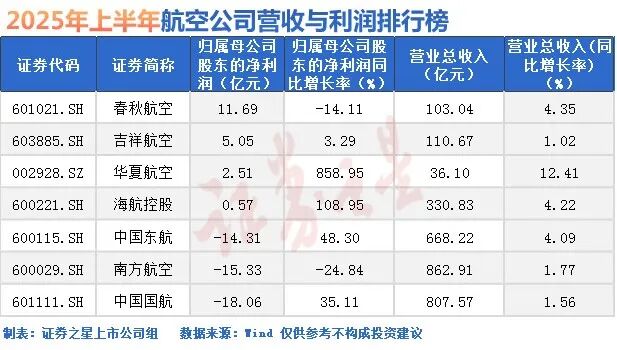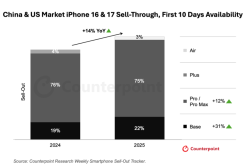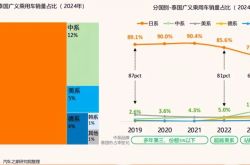Three Keywords in the Semi-annual Reports of Airlines in 2025
![]() 09/16 2025
09/16 2025
![]() 587
587
In the first half of 2025, China's civil aviation industry generally faced the dilemma of "increasing revenue without increasing profits" despite continuous growth in passenger volume. The three major state-owned airlines saw an overall reduction in losses but remained in the red, while Spring Airlines, with its extreme cost control, once again became the most profitable airline in the industry with a net profit exceeding 1.1 billion yuan. Meanwhile, the industry's "increasing volume but decreasing prices" and "cutthroat" competition have become constraints on development. Driven by both anti-cutthroat competition policies and market self-rescue efforts, the aviation industry may be standing at a critical turning point for high-quality development.
01. The three major airlines saw an overall reduction in losses in the first half of the year, with Spring Airlines remaining the most profitable
Specifically, China International Airlines, China Southern Airlines, and China Eastern Airlines, the three major airlines, all achieved positive revenue growth in the first half of the year, but their net profits attributable to shareholders of listed companies remained in the loss range.
In the first half of this year, Air China, China Eastern Airlines, and China Southern Airlines achieved revenues of 80.757 billion yuan, 66.822 billion yuan, and 86.291 billion yuan, respectively, with revenue growth rates of 1.56%, 4.09%, and 1.77%. None of the three major airlines achieved a turnaround in the first half of the year, with losses of 1.806 billion yuan, 1.431 billion yuan, and 1.533 billion yuan for Air China, China Eastern Airlines, and China Southern Airlines, respectively. Among them, Air China's losses narrowed by more than 30% year-on-year, and China Eastern Airlines' losses narrowed by nearly 50% year-on-year.

Regarding the failure to achieve a turnaround in the first half of the year, the three major airlines provided similar explanations in their previous performance forecasts. Air China mentioned in its announcement that it was affected by factors such as an unbalanced market supply, a sink (sinking) passenger source structure, the impact of the high-speed rail network, as well as the deepening uncertainty of the international environment and changes in the global industrial chain and supply chain.
China Eastern Airlines pointed out that it was affected by factors such as intense price competition in the domestic market and a complex and volatile international environment. China Southern Airlines noted that it was affected by multiple factors such as changes in passenger structure, the impact of high-speed rail, increasing unstable and uncertain factors in the international environment, disruptions in the global supply chain, and exchange rate fluctuations.
Meanwhile, HNA Group, Spring Airlines, Juneyao Airlines, and China Express Airlines, the four listed private airlines, have also recently disclosed their performance in the first half of 2025. Based on the data, Spring Airlines will once again become the most profitable airline in mainland China in the first half of the year.
In terms of profit scale, in the first half of 2025, Spring Airlines achieved a net profit attributable to shareholders of 1.169 billion yuan, a year-on-year decrease of 14.11%; followed by Juneyao Airlines with a net profit of 505 million yuan, an increase of 3.29%. China Express Airlines achieved a net profit of 251 million yuan, an increase of more than eight times, reaching a record high. Among them, Spring Airlines undoubtedly once again became the most profitable airline in China.
02. Spring Airlines' profit-making secret: Extreme cost control ability
The profit-making secret lies in its extreme cost control ability.
From an industry perspective, the aviation industry is a typical capital-intensive industry. Its fixed costs are extremely high (aircraft purchase/leasing, fuel, personnel wages, airport landing fees, maintenance costs, etc.), and its variable costs are also quite substantial. The average net profit margin of the global aviation industry is often only around 3%-5%. According to the International Air Transport Association's forecast, global aviation industry revenue will reach a record high of 979 billion US dollars in 2025 (accounting for 1% of the global economy), but costs will be as high as 940 billion US dollars, with a net profit margin of only 3.7%.
It's like carrying a huge money shredder in the air, burning money every minute. In this context, even a 1% cost saving can directly translate into profits and determine whether a company is profitable or not. Moreover, aviation services, especially on medium and short-haul routes, are highly homogeneous. For most passengers, the core value (safe arrival) provided by different airlines from point A to point B is similar. Therefore, price becomes the most direct and effective competitive weapon.
Therefore, only airlines with effective cost control have greater pricing flexibility. They can achieve higher profits when not offering discounts and can also participate in price wars with lower fares without suffering severe losses. The success of low-cost airlines (such as Southwest Airlines, Ryanair, and Spring Airlines) is essentially the success of the extreme cost control business model.
Spring Airlines also pointed out in its semi-annual report that, unlike full-service airlines, the company positions itself as a low-cost airline business model, attracting a large number of price-sensitive self-paid passengers and cost-conscious business travelers with its price advantage.
As a result, low-cost airlines often have three common characteristics:
First, they prefer to use a single aircraft model to reduce expenses on operational equipment and personnel training. For example, all of Spring Airlines' aircraft are Airbus A320s, while Southwest Airlines only purchases Boeing series aircraft.
Second, all seats are economy class, allowing for more seats to be placed.
Third, they save on more service costs, such as not providing in-flight meals and no free baggage allowance. For example, Southwest Airlines even uses plastic boarding passes to reduce costs through reuse.
03. The phenomenon of "high passenger volume but low profits" is prominent, and the industry urgently needs to combat cutthroat competition
In addition, the entire industry still faces the phenomenon of "high passenger volume but low profits".
According to data from the Civil Aviation Administration of China, in terms of business scale, from January to June, the number of newly registered domestic connecting flight filings reached 33,300 groups, a year-on-year increase of 95.47% compared to 2024; the daily average number of connecting flights operated, connecting passengers, and transported baggage were 2,213 flights, 7,128 passengers, and 3,824 pieces, respectively, representing year-on-year increases of 2.42 times, 1.94 times, and 2.02 times compared to 2024; 1,599 new city pairs were added, a year-on-year increase of 24.05% compared to 2024; and a cumulative total of 213 airports were reached, accounting for over 80% of domestic transport airports. In addition, 8,240 new cross-airline connecting flight filings were added in the first half of the year, accounting for 29.22% of the total new connecting flight filings, a year-on-year increase of 36.4% in proportion.

Despite this, major airlines, including Spring Airlines, saw a decline in passenger business revenue in the first half of the year. Financial report data shows that Spring Airlines' average revenue per passenger kilometer in the first half of the year was 0.377 yuan, a year-on-year decrease of 4.24%, with domestic routes seeing a decrease of 4.85% and international routes seeing a decrease of 5.47%. Air China's financial report shows that its revenue per passenger kilometer for domestic and international routes decreased by 6.2% and 0.8% year-on-year, respectively. China Eastern Airlines' revenue per passenger kilometer for domestic, international, and regional routes decreased by 7.92%, 5.39%, and 3.60%, respectively.
For airlines, the decline in airfare prices is an important reason for the decline in revenue. A report by Flight butler shows that the average domestic civil aviation economy class fare in the first half of this year was 749 yuan, a year-on-year decrease of 6.9% compared to 2024 and a decrease of 7.8% compared to 2019.
In response, over the past two months, the Civil Aviation Administration of China has held two meetings emphasizing comprehensive rectification of "cutthroat" competition in the civil aviation sector. On August 14, the "Self-Regulatory Convention on Air Passenger Transport of the China Air Transport Association," led by the China Air Transport Association, was officially released, explicitly proposing to "eliminate malicious competition aimed at excluding competitors," which may improve airlines' revenue levels in the short term.
Facing the situation of "increasing volume but decreasing prices," airlines are also constantly expanding their markets, from optimizing ground processes to launching personalized value-added service initiatives. For example, China Eastern Airlines pointed out in its financial report that it adheres to the "aviation+" concept and innovates product marketing models. In the first half of this year, it achieved online sales revenue of 6.1 billion yuan, a year-on-year increase of 30%; and new retail revenue exceeded 2.258 billion yuan, a year-on-year increase of 24.77%. At the same time, it enriched its multimodal transport products, including air-rail, air-bus, air-water, and air-rail intermodal services.
In conclusion, despite short-term pressures, by optimizing operations, expanding value-added services, and responding to anti-cutthroat competition policies, the domestic aviation industry may gradually move towards a healthier track of high-quality development.
- End -








